Family : Synodontidae

Text © Giuseppe Mazza

English translation by Mario Beltramini
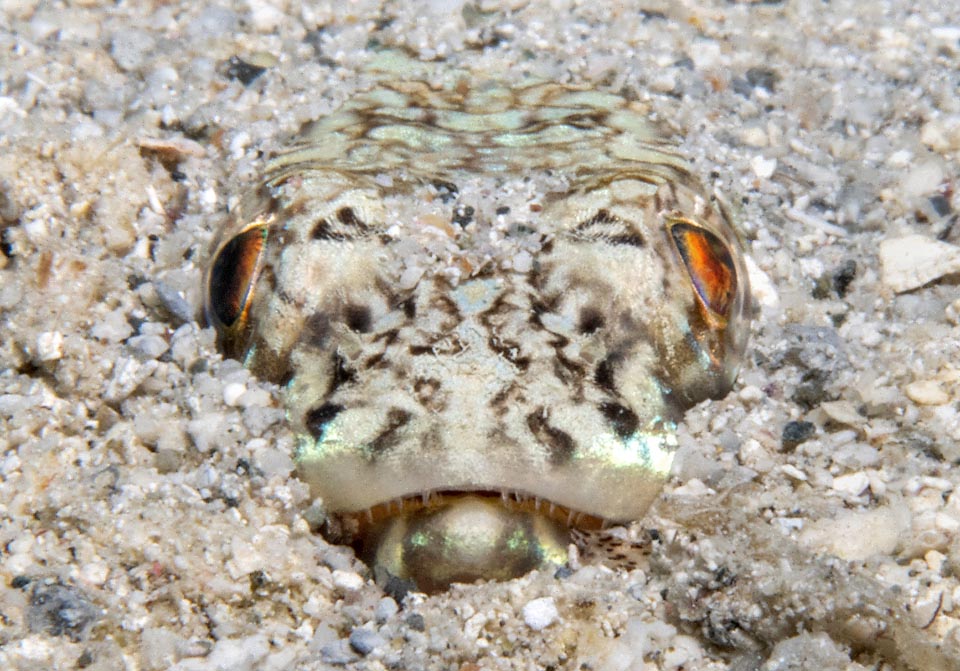
Synodus intermedius is a lizardfish of Tropical Atlantic who defends itself from predators and tends ambushes often hidden in the sand © Allison & Carlos Estape
Synodus intermedius (Spix & Agassiz 1829) belongs to the class of the Actinopterygii, the ray-finned fishes, to the order Aulopiformes and to the family of the Synodontidae, that of the so-called lizardfishes, group appeared in the Miocene counting presently 4 genera and 81 species.
When seen, with those long jaws, the small protruding eyes on the sides and the long and tapered body that gets thinner towards the peduncle, actually makes you think of a saurian, hence the common French name of “Anoli de sable”, that is Anolis of the sand, taking into account this relative to the iguanas, very frequent in tropical America, and the fact that it usually hides up to its neck under the sand to escape predators and surprise preys.
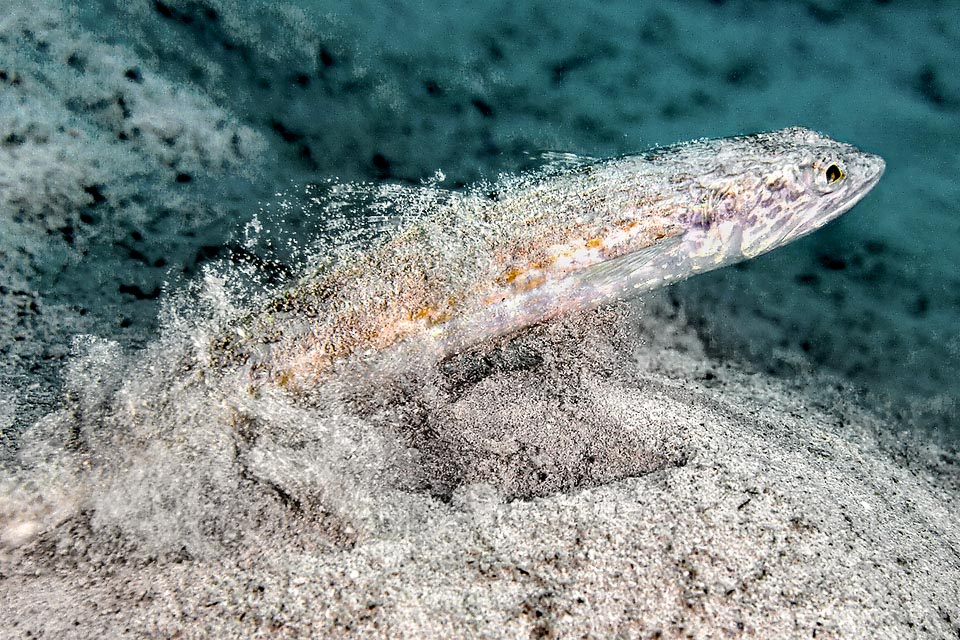
As soon as it sees a prey shoots out quickly with its lizard-like snout to catch it with its small countless needle-like teeth © Allison & Carlos Estape
But Synodus intermedius is also known as Yellow striped lizardfish, Caribbean lizardfish or Sand diver.
The name of the genus Synodus comes from the Greek “syn” together and “odous”, tooth, with reference to the numerous small teeth growing very close to each other.
The specific term intermedius, not explained by the Author in the description of the species, might refer to the drawing of the livery with rhombuses interspersed with spots or perhaps to the fact that this species has characters intermediate to other two species.
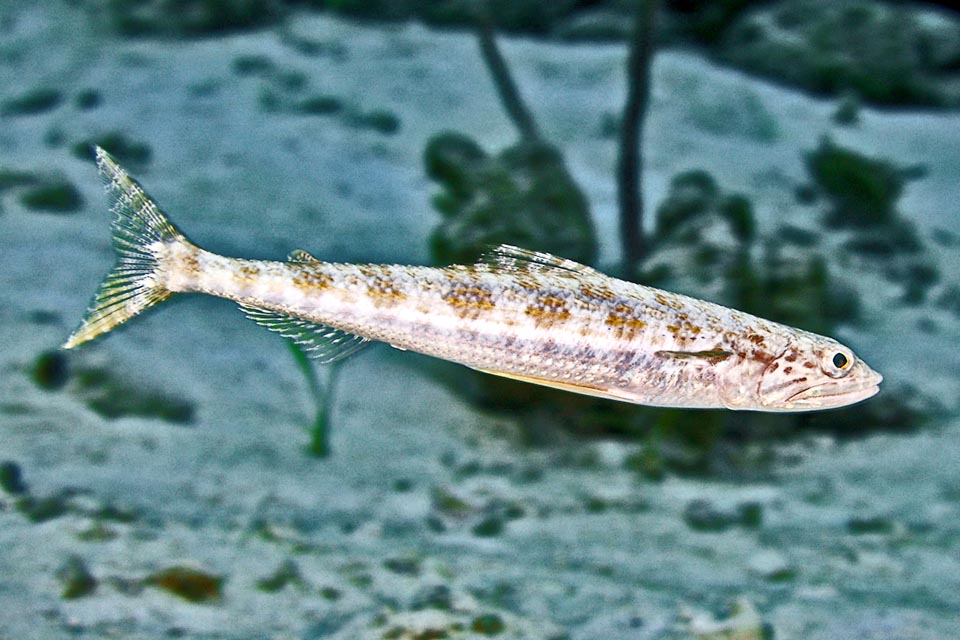
25 cm long on average with fusiform body pushed by the strong falcate caudal fin, is so quick in its movements that it is not always easy to spot it while swimming © Allison & Carlos Estape
In fact, for instance, it resembles Synodus saurus (Linnaeus, 1758) that, however, does not have the typical rectangular black spot at the upper extremity of the gill fissure, and Synodus synodus (Linnaeus, 1758) that, conversely, presents a black spot on the snout, one less ray on the anal fin and a redder livery with wide vertical dark bands.
Zoogeography
Synodus intermedius has a very vast distribution.
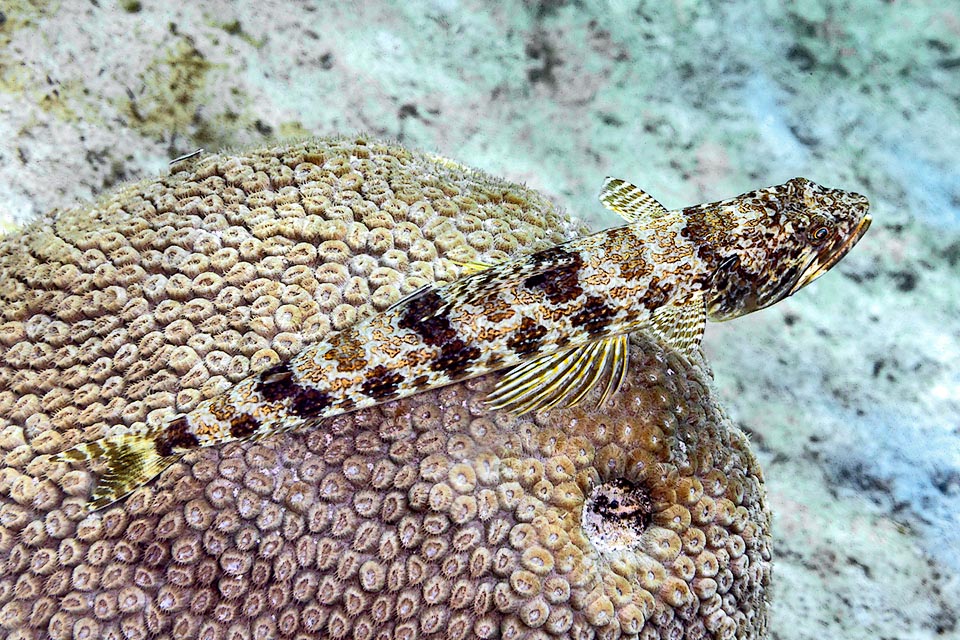
Mimetic as it is, it can also spot motionless from the top of a madrepore the passing by victims. Here we note all the details of the splendid livery: the dark dorsal spots as well as the 8 rhombi on the sides, the traits on the fins and its elegant golden irregular lines crossing the back up to the caudal peduncle © Allison & Carlos Estape
Starting northwards from the Caribbean reaches the shores of Canada and southwards Uruguay. Then eastwards, after the Archipelago of Trindade and Marim Vaz, we find it in the middle of the ocean in the islands of Ascension and St. Helen, and finally in São Tomé and Príncipe, Cabo Verde, Canaries and Madeira on the other side of the Atlantic.
Ecology-Habitat
Synodus intermedius is a demersal species, that is, living close to the seabed.
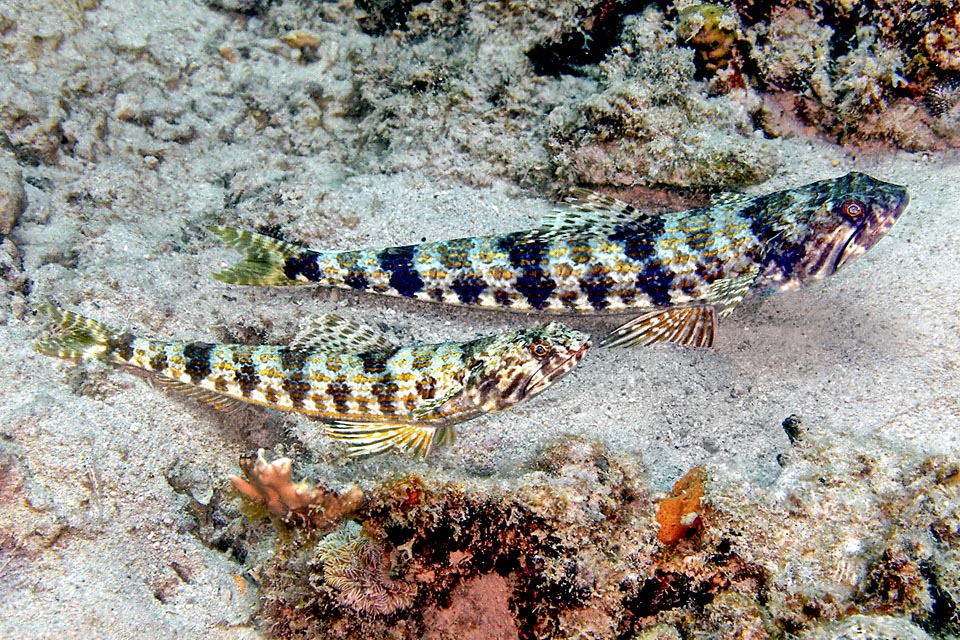
Present also on the sides and between one rhombus and other, down, are visible other dark dots on a clear band followed by another golden line © Allison & Carlos Estape
It can be found in sandy environments up to about 300 m of depth, but also in the shallow waters of the reefs, at times in the sandy corridors created by the currents or in plain sight on a madrepore having a dominant position, where supported by its large pelvic fins looks around motionless, camouflaged, setting ambushes for the passing fishes.
Morphophysiology
Synodus intermedius may reach the length of half a metre, even if its average size is of around 25 cm.
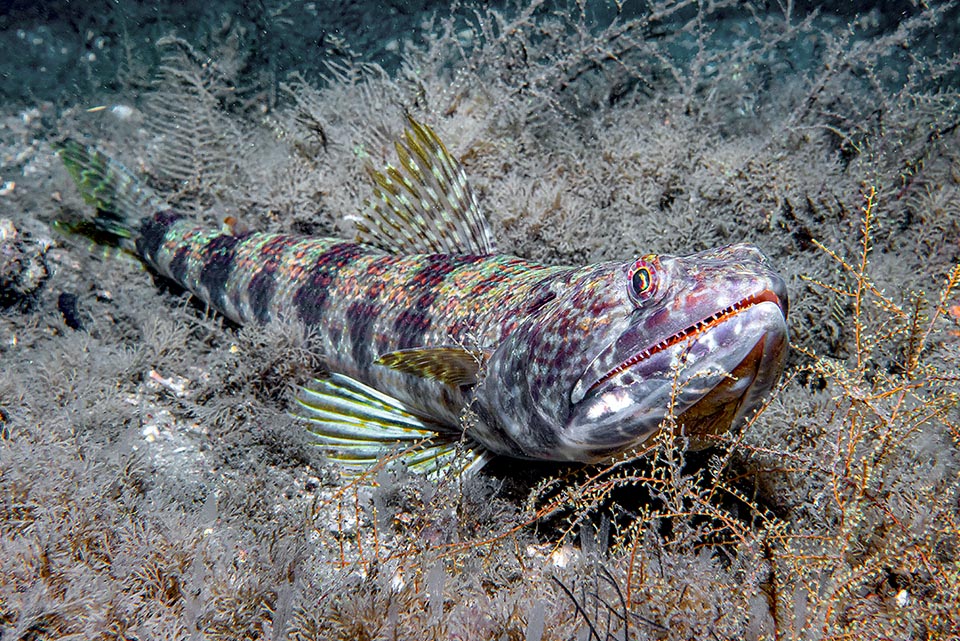
However all these drawings and colours are quite variable due to the chromosomes that adapt the mimetic livery depending the environmental needs © Brian Cole
The snout is short with a flat head, triangular when seen from above. The mouth is full of small needle-shaped teeth. They are arranged in two rows on the upper jaw and on three rows in the lower one, in both cases shorter in the external one. And as if that was not enough, it has 3-4 series of teeth on the palate and 5 on the tongue.
Conversely, the fins do not have spiny rays. The dorsal has 11-12 soft rays, the pectoral ones 11-13, the anal fin 11 and the pelvic ones 8.
The caudal fin is falcate, as is appropriate to a fish capable of fast flashes, so rapid that it is rare to observe it while swimming.
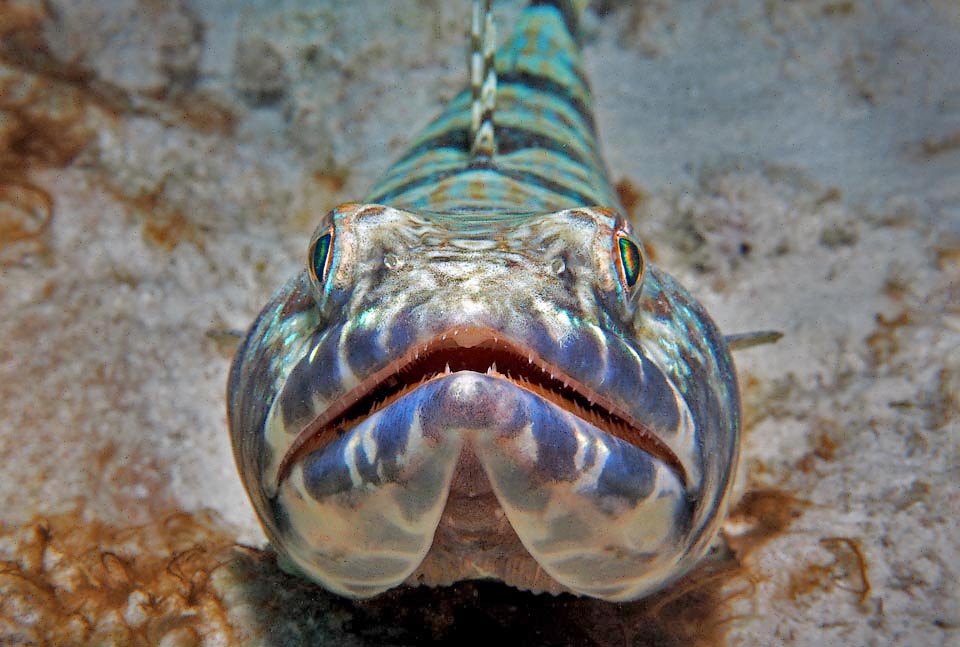
We discover here unattended emerald green and blue hues. The huge mouth ajar shows the first row of teeth. Others are behind it, present also on the palate and tongue © Pauline Walsh Jacobson
The scales are big and the colour of the mivery, grey, brownish or greenish is extremely variable due to the chromatophores that imitate the surrounding environment. On the back, crossed by brown-reddish vertical bars, we note elegant and thin mimetic golden horizontal lines, going, with irregular lines, from the head to the caudal peduncle. They also continue on the sides where, however, catch the eye 8 dark rhomboidal spots, spaced below by other smaller ones.
The dorsal fin and the pectoral ones are crossed by dark bands as well as the lobes of the caudal that have 3-5 more marked bands.
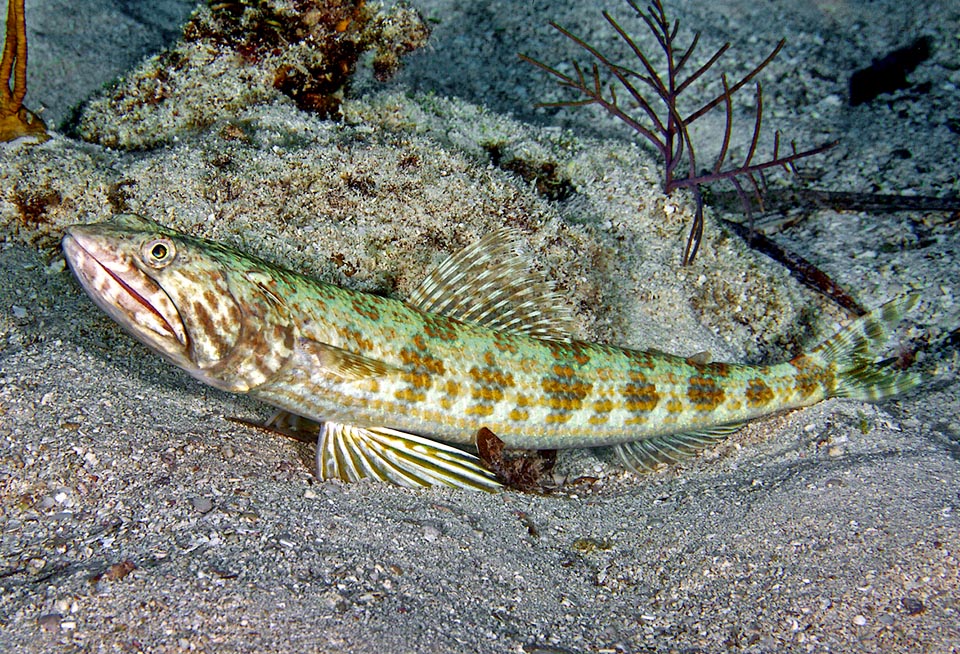
Synodus intermedius is a species feeding mainly of fishes but also of mollusks, like cuttlefishes and squids, and crustaceans © Allison & Carlos Estape
The anal fin is yellow like the pelvic ones that display a darker pigment among the rays. The ventral side of the fish is whitish, as usually is the case for the species living on the seabeds.
Ethology-Reproductive Biology
Synodus intermedius nourishes mainly of fishes. In particular of Haemulidae like Brachygenys. chrysargyreum and similar species, Clupeiformes like Jenkinsia lamprotaenia or Jenkinsia majua and even of various predators moving on the seabeds like Serranus tigrinus, Serranus baldwini, Serranus tabacarius and other species belonging to this genus.
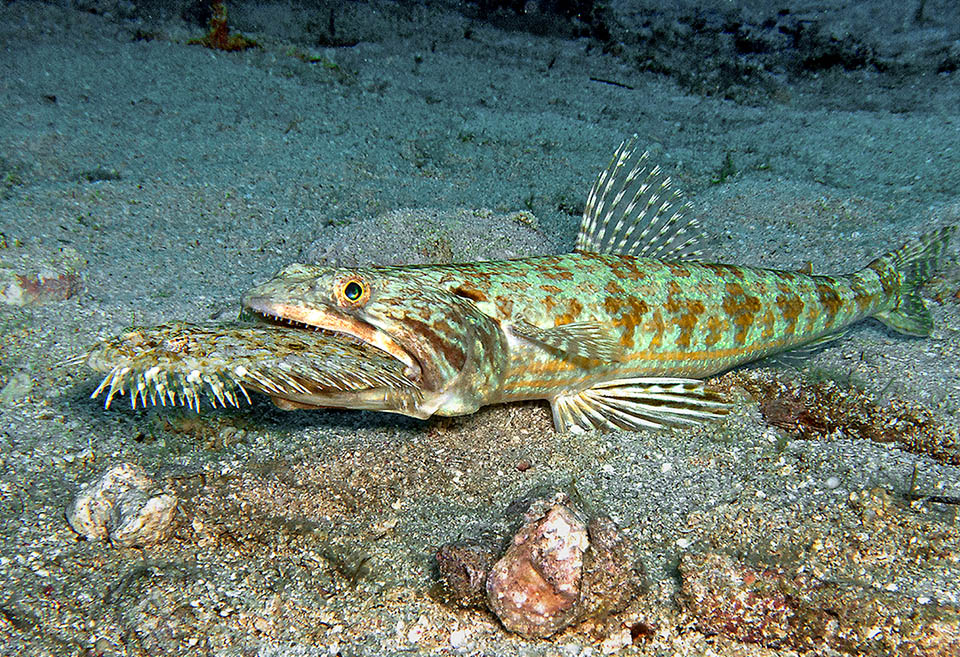
Here has just seized a Bothus ocellatus, young unlucky hunting colleague, who was also hunting in ambush hidden under the sand with its bulging eyes © Mickey Charteris
Often do enter its diet also labrids and turbots like Bothus ocellatus it often finds nearby, buried like it in the sand.
Finally, it nourishes also of mollusks, with a predilection for cuttlefishes and squids, and of crustaceans, mostly shrimps.
However it respects a tiny and graceful blue shrimp, Ancylomenes pedersoni, sometimes present in the “cleaning stations” where the big fishes go to get the parasites removed from their skin.
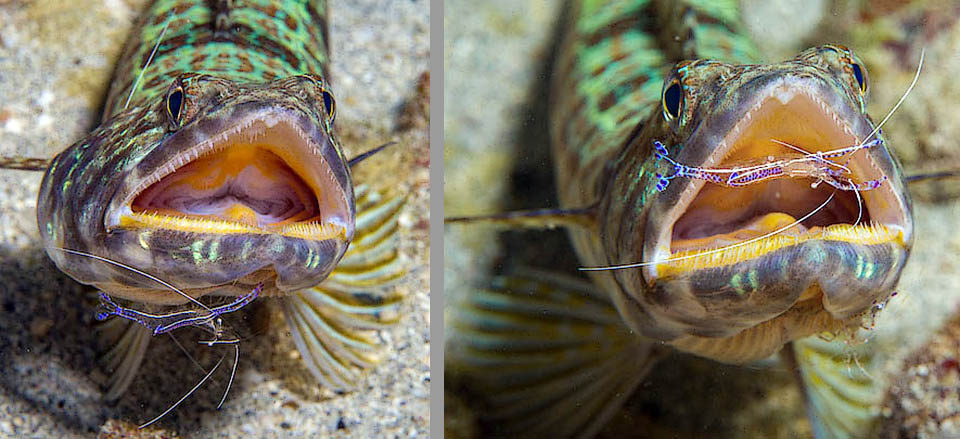
After the meal Synodus intermedius needs often to clean up its teeth and of this takes care Ancylomenes pedersoni, small blue shrimp who removes also the parasites © Allison & Carlos Estape
Synodus intermedius besides a dermatologist for getting rid of the isopods and other small pests, serves also, with all the teeth it has, an accurate dentist, like, rightly, the Pederson’s cleaner Shrimp who lives in symbiosis with sea anemones like Bartholomea annulata or Condylactis gigantea.
In fact, this, as soon as it sees it, abandons immediately with a group of comrades its “turris eburnea” to free it from the food leftovers it finds between one tooth and another.
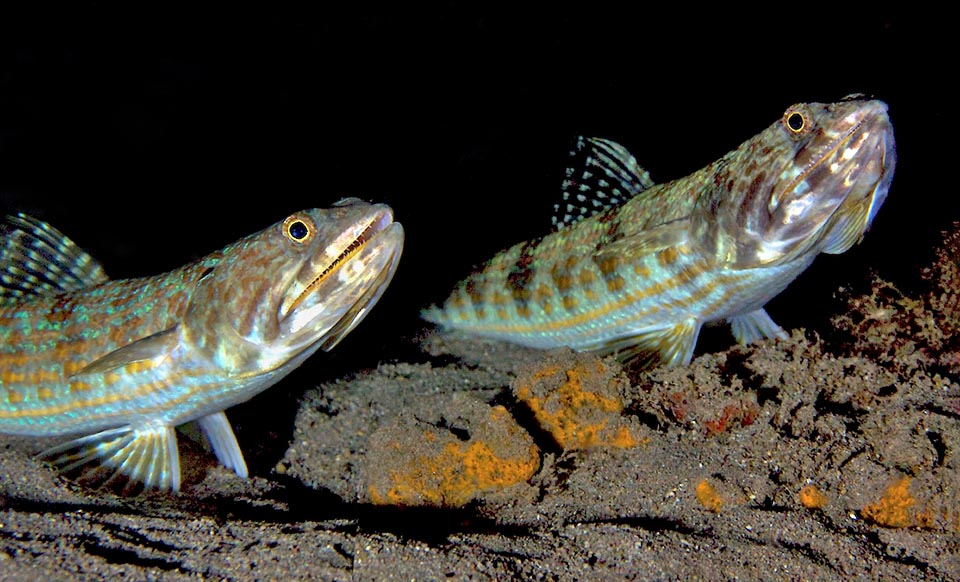
Reproduction of Caribbean lizardfish is poorly known, apart from the fact that the eggs are fecundated on the seabeds and abandoned to their fate © Allison & Carlos Estape
The reproduction of Synodus intermedius, usually happens in summer or in autumn, and is poorly documented. We know only that the eggs are laid on the seabeds and that after the fecundation the parents separate and that there are no parental cares.
The resilience is mediocre, with a possible doubling of the populations in 1,4-4,4 years.
The flesh has poor commercial value, but as it may reach the weight of 1 kg, in some sites, like Haiti, Synodus intermedius sometimes ends up in the pot.
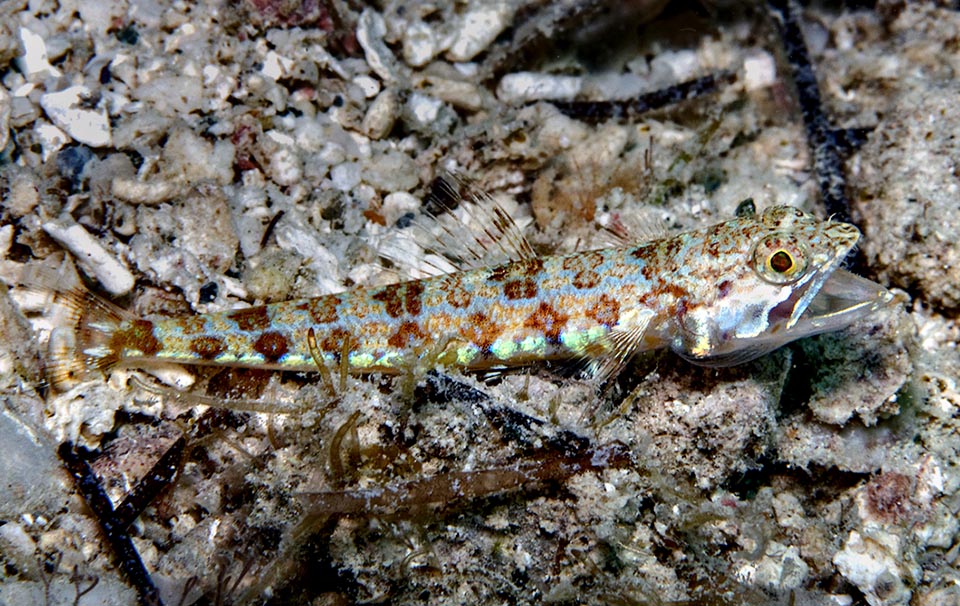
Juvenile. We glimpse, simplified, the livery of adults with the characteristic rhomboid drawings and golden forming lines, already showing the grit of its ravenous parents © Allison & Carlos Estape
The fishing vulnerability keeps in any case moderate, marking 36 on a scale of 100, and in the IUCN Red List of the endangered species it appears from 2013 as “LC, Least Concern”.
Synonyms
Saurus intermedius Spix & Agassiz, 1829.
→ For general information about FISH please click here.
→ For general information about BONY FISH please click here
→ For general information about CARTILAGINOUS FISH please click here.
→ To appreciate the BIODIVERSITY of BONY FISH please click here.
→ To appreciate the BIODIVERSITY of CARTILAGINOUS FISH please click here.
